Whenever I am looking for an art oasis here in San Francisco, I try to plan a visit to the live-work space of Silvia Poloto. With Silvia, the line dividing her life 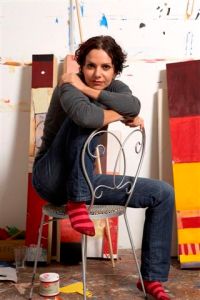 from her art is definitely blurred. She lives in a space where she is completely surrounded by her art – works both finished and in progress. Her life permeates her art and it is, in turn, permeated by it. She told me that she cannot imagine living in a space where she could not immediately access her paintings at any time. It is not that she needs to be constantly working; but, ideas for work can come to her at any time and she loves being able to walk into her adjacent studio when that happens.
from her art is definitely blurred. She lives in a space where she is completely surrounded by her art – works both finished and in progress. Her life permeates her art and it is, in turn, permeated by it. She told me that she cannot imagine living in a space where she could not immediately access her paintings at any time. It is not that she needs to be constantly working; but, ideas for work can come to her at any time and she loves being able to walk into her adjacent studio when that happens.
On one memorable Sunday afternoon, more than a dozen intrepid art trekkers made their way to her Mission loft. There we sat around drinking fine wine and nibbling on artisan cheeses, while Silvia held court. Silvia is a great story-teller and her story is both inspiring and moving. Raised in Brazil, she was born into a family and a society that was not particularly supportive of any artistic ambitions. For her parents, the academic achievements of her brothers, leading to careers in engineering, were praise-worthy. So, intensely competitive by nature, she focused on academics. She entered the best engineering schools; became a sales engineer; and went on to get an MBA – all to prove to everyone that she was as good as or better than her brothers. Becoming an artist was not an option – not even a dream.
Then, love entered the picture and everything changed. Everything became possible. She met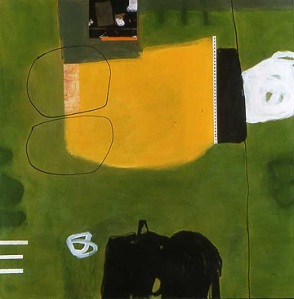 her Irish husband on a beach in Brazil. After a whirlwind romance, they married. Billy won the Irish “U.S. green card” lottery and off they went to live in the United States. Three months after moving here to San Francisco, and without the familial and societal pressures, Silvia decided that she had become an engineer for all the wrong reasons; and she quit. She took some metal-working classes at City College of San Francisco and started making sculpture. She actually worked as a welder for a short time. But her art quickly gained traction. Her art professors recognized her talent and encouraged her. She got a merit scholarship to the Art Institute, but dropped out quickly because she needed to focus on actually making art to meet the demand. Galleries started representing her. Art consultants sought her out. When she stopped making sculpture and turned to painting, they all came along for the ride. It was, in many ways, a charmed life. Then, tragically, her husband, who was both her best friend and an important partner in her career, became seriously ill. In early 2009, she lost him to cancer. On that visit to her studio, he was omni-present in both a large series of photographs and in a funerary art piece she created. It has been incredibly challenging, but we all got a sense of just how strong, just how determined Silvia is.
her Irish husband on a beach in Brazil. After a whirlwind romance, they married. Billy won the Irish “U.S. green card” lottery and off they went to live in the United States. Three months after moving here to San Francisco, and without the familial and societal pressures, Silvia decided that she had become an engineer for all the wrong reasons; and she quit. She took some metal-working classes at City College of San Francisco and started making sculpture. She actually worked as a welder for a short time. But her art quickly gained traction. Her art professors recognized her talent and encouraged her. She got a merit scholarship to the Art Institute, but dropped out quickly because she needed to focus on actually making art to meet the demand. Galleries started representing her. Art consultants sought her out. When she stopped making sculpture and turned to painting, they all came along for the ride. It was, in many ways, a charmed life. Then, tragically, her husband, who was both her best friend and an important partner in her career, became seriously ill. In early 2009, she lost him to cancer. On that visit to her studio, he was omni-present in both a large series of photographs and in a funerary art piece she created. It has been incredibly challenging, but we all got a sense of just how strong, just how determined Silvia is.
 Silvia has worked in sculpture, photography and video, in addition to painting. And all of these make their way into her artistic process. With photography and sculpture, the idea usually comes first. These are what she calls “thinking pieces”. She has a vision and she sets out to realize the vision in the work. However, she pointed out that “there is a space of not thinking, even in the thinking pieces”. With painting, it is more overtly “not thinking”. Her goal is to allow her sub-conscious to direct the pieces. The works are not really planned out in advance. These are what she calls “intuitive pieces”. They develop naturally. I asked her a question that I often ask abstract artists: “How do you know when it is done?” In her inimitable style, she stated with absolute confidence that “I always know when it is done; it is very clear”. She realizes that other abstract artists have a hard time knowing when to stop. They hang paintings on the wall for weeks to be certain that the work does not need something else. But for her, there is clarity and certainty. When a work is done, it is done. In both art and life, she is striding forward confidently.
Silvia has worked in sculpture, photography and video, in addition to painting. And all of these make their way into her artistic process. With photography and sculpture, the idea usually comes first. These are what she calls “thinking pieces”. She has a vision and she sets out to realize the vision in the work. However, she pointed out that “there is a space of not thinking, even in the thinking pieces”. With painting, it is more overtly “not thinking”. Her goal is to allow her sub-conscious to direct the pieces. The works are not really planned out in advance. These are what she calls “intuitive pieces”. They develop naturally. I asked her a question that I often ask abstract artists: “How do you know when it is done?” In her inimitable style, she stated with absolute confidence that “I always know when it is done; it is very clear”. She realizes that other abstract artists have a hard time knowing when to stop. They hang paintings on the wall for weeks to be certain that the work does not need something else. But for her, there is clarity and certainty. When a work is done, it is done. In both art and life, she is striding forward confidently.
Personally, I was first drawn to Silvia’s work when I encountered two mixed media pieces featuring pigs. The pieces were “in progress” at Trillium, a local printer for artists and they were very complex. Plexiglas boxes had been built and filled with painted panels, sculptural insets and toy pigs. The works explore the human condition, with the pigs playing the leading role of the humans. In one of my favorite works: “Reverence”, the pigs hanging from meat hooks have a certain medieval quality of religiosity. The works were both engaging and disturbing. Two of this series of works are in Silvia’s collection and I frequently revisit them.
The “Pigs” series was a progression from an earlier series from 2004, “Unresolved”. This was the first series where Silvia technically brought together h er sculpture, her photography and her painting. The works here were less ambiguous. Titles for the works, such as “Betrayal” and “Vows”, were very much descriptive of the subject matter. With “Pigs”, there was much more room for the viewer to bring their perspective to the work. Even for Silvia, who lives with the “Pigs” in her bedroom, her evolving experiences have changed the meaning of the works for her, as well. These are works that do not sit still. They morph.
er sculpture, her photography and her painting. The works here were less ambiguous. Titles for the works, such as “Betrayal” and “Vows”, were very much descriptive of the subject matter. With “Pigs”, there was much more room for the viewer to bring their perspective to the work. Even for Silvia, who lives with the “Pigs” in her bedroom, her evolving experiences have changed the meaning of the works for her, as well. These are works that do not sit still. They morph.
I was very pleased to see Silvia return to this kind of artistic exploration when I recently visited her loft. She is once again working on large assemblages. This series is aptly titled “Private Puzzles”. Once again, she has built elaborate frames that combine photographic, painted and sculpted elements. However, when she started on these new works, her original thought was to print the photographic elements very large on watercolor paper. This proved to be prohibitively expensive. So, instead, she printed the i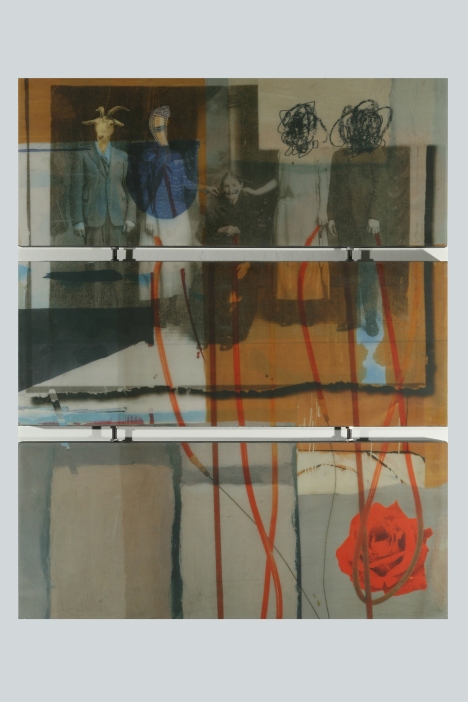 mages in sections. She then found herself rearranging the different sections in various combinations. It is a very physical exploration of the artistic possibilities that allows her to take images that are well-thought out, then combine her abstract sensibilities to move the sections into compositions that are built sub-consciously.
mages in sections. She then found herself rearranging the different sections in various combinations. It is a very physical exploration of the artistic possibilities that allows her to take images that are well-thought out, then combine her abstract sensibilities to move the sections into compositions that are built sub-consciously.
I am particularly fascinated with her work, “Family Tree # 1”. Here Silvia has explored the “Spanish” side of her family tree – her mother’s family. The Spanish women were formidable, dominating family life. At the same time, they were vulnerable to physical domination and abuse by the men. Silvia takes three separate panels and physically unites them with steel bolts. Her grandparents and great-grandparents populate the top panel. The ties bind the middle and subsequent generation, reaching down to Silvia’s oft-repeated and self-identifying rose. It is serious work. At the same time, it is humorous work. There is a particular subject to the work. And, there is an ambiguity to the work where the viewer can enter it and make it their own.
Silvia Poloto is represented at numerous galleries nationwide (see “contact & galleries” on her website). In April, she will be participating in 2011 Spring Open Studios at ARC Gallery, April 1-3; and at her live-work loft, April 16-17. She also will be participating in 2011 San Francisco Fall Open Studios this coming October, also at both locations. And, her studio is open by appointment.
Filed under: Artist Profile, San Francisco Open Studios, Silvia Poloto, Tour des Artistes | 1 Comment »



 in San Francisco. This show has traditionally been dedicated to victims of violent death in the Bay Area. It is not, however, simply or exclusively a memorial to those who have died. It is also about those left behind and it is about art’s power to heal. For the exhibition, artists create installation pieces of reverence and remembrance. Often the installations are rooms – full scale assemblages.
in San Francisco. This show has traditionally been dedicated to victims of violent death in the Bay Area. It is not, however, simply or exclusively a memorial to those who have died. It is also about those left behind and it is about art’s power to heal. For the exhibition, artists create installation pieces of reverence and remembrance. Often the installations are rooms – full scale assemblages. 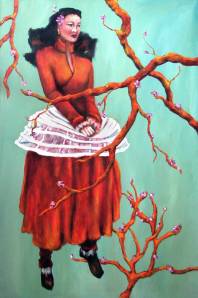 that seed, gradually adding context and narrative to the work. The process can be a long one and she is often working on as many as 20 pieces at a time. Her background did not provide the opportunity for formal training in an art school. However, my guess is that this is fortunate. The unique combination of whimsy with a serious message that is present in her best work probably would not have benefited from a BFA degree.
that seed, gradually adding context and narrative to the work. The process can be a long one and she is often working on as many as 20 pieces at a time. Her background did not provide the opportunity for formal training in an art school. However, my guess is that this is fortunate. The unique combination of whimsy with a serious message that is present in her best work probably would not have benefited from a BFA degree.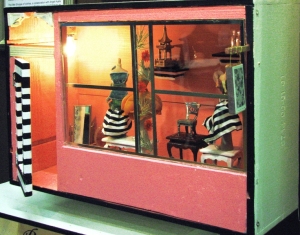 and shadows. The stories were harrowing. Like many Chinese of their generation, her parents were reluctant to talk about them.
and shadows. The stories were harrowing. Like many Chinese of their generation, her parents were reluctant to talk about them.